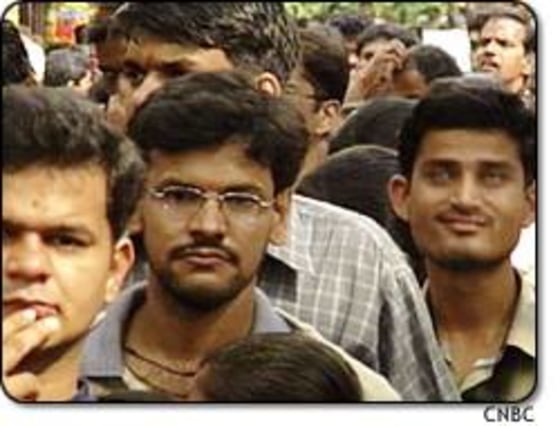Just as the Internet boom was exploding in the United States in the mid-1990s, another tech epicenter was emerging 8000 miles away in Hyderabad, India.
Young software engineers and call center technicians have gone in droves to the place President Bill Clinton dubbed the Silicon Valley of the East.
How Hyderabad was transformed from ancient city into a cyber-city is quite remarkable.
While much of the country is lacking in infrastructure, plagued with poverty and urban decay — Hyderabad is a shining example of what India could become.
Located in the middle of the country, it has become home away from home for American giants like IBM, Microsoft, Dell, General Electric and Oracle.
They have all come to this hi-tech city for two simple reasons.
“We are utilizing India to maintain GE’s global competitiveness through India’s huge intellectual talent,” said Scott R. Bayman, president & CEO of GE India. “And the secondary importance for India is more long-term … the local market.”
GE, the parent company of CNBC and a joint-venture partner with Microsoft in MSNBC, now employs roughly 6500 people in Hyderabad. Oracle now has close to 4000 employees. They are helping to make Hyderabad one of the fastest growing economies in India with an ever-increasing tax base.
The bulk of those taxes are coming from the people who now live in mansions that could be plucked from the hills of Hollywood. And the level of success found in Hyderabad is no small accomplishment in a country where sound infrastructure has always been a concept, never a reality.
I joked that when I got here you wondered when you picked up the phone if you’d have dial tone, and if you did, could you get connected and stay connected,” Bayman said. “Now all of that has changed. The growth of cellular and land lines as the government has opened it up to private enterprise and competition. Costs are down, quality of service is up.”
The physical landscape of Hyderabad has also gone through massive change. Acres of shabby buildings have given way to dozens of architecturally diverse business centers.
Centers that are now home to the likes of Arvind and Dharani Kanda — husband and wife engineers who chose to stay in this thriving city rather than work abroad.
“Career advancement, life, everything is better here,” Arvind Kanda said. “We don’t feel that we’re missing anything by staying here.”
The man who deserves the lions share of credit for transforming this city is a very progressive politician named Chief Minister Chandrababu Naidu.
The chief minister is a very aggressive, positive and dynamic individual.
Minister Naidu — who was elected in 1995 — has skyrocketed to cult status. There are Naidu fan Web sites, his image adorns lamp poles and he draws a crowd wherever he goes.
“Because of my reforms, people are getting better services, better living standards and better amenities,” Minister Naidu said.
In the face of fierce resistance, Minister Naidu has still managed to usher many of the people who elected him into the 21st century. In fact, Hyderabad is not just a city for high tech, it is truly becoming a high-tech city.
Minister Naidu has moved forward to put virtually the entire government infrastructure, from crime fighting and property rights, even the way people pay their electricity bills, on-line. This has Oracle and every other American company with development centers in Hyderabad champing at the bit.
“Because of this activity, many people got jobs,” Minister Naidu said. “They are getting better wages. Because of better earnings they are spending more money. In turn, we are getting taxes.”
In this city of 5.5 million people, American companies have benefited greatly from the fiscal and administrative reforms initiated by Naidu. Only time will tell , however, whether other Indian states will follow his progressive policies.
But his embrace of western capitalism has gotten Minister Naidu into serious trouble. Earlier this month, he was injured when a landmine exploded under his vehicle.
The Peoples War Group, a Marxist organization claimed responsibility for the attack that occurred just hours after we interviewed him at his residence. Naidu survived with a only a fractured collar bone and minor abrasions.
Chief Minister Naidu continues to recover from the attack. As for his future plans for the hi-tech city, he anticipates Hyderabad becoming a transit hub between Europe and Asia. With a new medical center and international convention center opening next year.
Hyderabad has changed dramatically over the last five years and most expect it to continue to grow. If it does, things are looking very good for India’s high-tech city.
